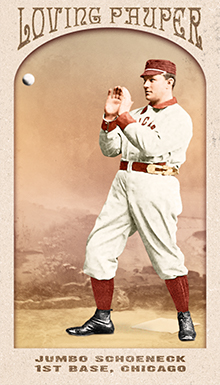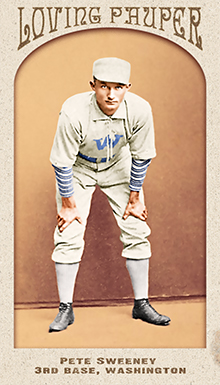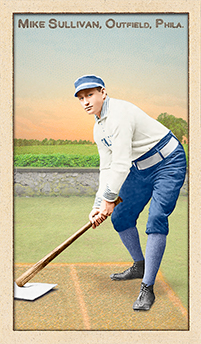
- Series: 1880s: Loving Paupers
- City: Chicago
- Team: Maroons
- League: Western Association
Lewis N. Schoeneck (1862-1930) came by his nickname honestly, standing 6'2” and 223 lbs, a true Gargantua in his day. Despite his size and presumed strength, Schoeneck proved better suited to the minors than the big leagues. His decade in pro ball was mostly in those smaller circuits and, apart from his season with the Union Association in which he played for two clubs and saw pitching a decided cut below true major league caliber, his batting average was consistently much higher in the minors. This is, of course, not unique by any means and the big first baseman was able to perform very well for most of the franchises he played for. Thanks to the renegade UA that siphoned off a lot of upper-tier minor league talent to make its attack on National League dominance in 1884, many of its players enjoyed one sunny season hitting well above their pay grade. Jumbo, for example, was in the top ten in the league in many offensive categories, including BA, OBP and Slugging Percentage. Since his only other major league time came four years later with the Indianapolis Hoosiers of the NL, his summer of love with the Pittsburgh Stogies and Baltimore Monumentals (never mentioned in connection with baseball greatness) enabled Schoeneck to “retire” with a career major league batting average of .283. Not a bad accomplishment to tell the grandkids.
- During his first of two seasons with the Hoosiers in 1888, Jumbo was summoned to relieve in two games. He hurled 4.1 innings, surrendering five hits and four runs without a decision. All of the runs were unearned giving him a phenomenal career ERA
- Neither of Jumbo's UA clubs performed too badly, but all of the league's other teams were crushed by the St. Louis Maroons who made mincemeat of the competition. The lop-sidedness of the runaway Maroon steamroller played a large part in demoralizing the fans and leading to the league's demise after that storied '84 campaign. St. Louis was a big winner in another, more important way. Their achievement led to the franchise graduating to the NL in 1885 where they became cellar-dwellers
Auction History
Cartophilia
Old Judge Pose: 404-4

- Series: 1880s: Loving Paupers
- City: Washington, D.C.
- Team: Nationals
- League: National League
Peter Jay Sweeney (1863-1901) played infield and outfield on the west coast beginning at the tender age of 15 with two San Francisco clubs. He moved across the bay to Oakland in 1881, then came back to Baghdad by the Bay with the SF Haverlys in 1884-85. At age 24, Pete got his big chance, joining the Washington Nationals in '88. He returned to D.C. the following season and was moved to the St. Louis Browns later in '89. They demoted him briefly to the St. Paul Apostles, but brought Sweeney back in 1890 before trading him to the Philadelphia Athletics who sent him later the same season to the Louisville Colonels. His major league tenure ended in Louisville with Pete seeing action for four clubs in a mere three years. He was far from finished with baseball, however. Sweeney had a coast-to-coast season in 1891, playing back home for Oakland and finishing the year with the Rochester Hop Bitters in the Eastern Association. Thereafter, this wanderer would roam from California League teams to the east coast and even a season with the Nashville Tigers of the Southern League. Having begun in 1879, this lifer didn't hang 'em up until concluding the 1897 campaign with the Sunbury Pirates of the Central Pennsylvania League. There was a reason he spent most of his time in the minors: he couldn't hit big league pitching. Pete's average for his four MLB clubs was a paltry .209. Yet, he could thrive in the lower levels of the game. When he left the big leagues for Rochester, Sweeney led the Eastern Association in home runs.
- Not a lot of native Californians got to play in the majors in the nineteenth century, but while playing for the San Francisco Knickerbockers in 1879, Sweeney did play alongside one early luminary: The Only Nolan. A pitcher, perhaps from Canada, Edward Nolan sported one of the great appellations in the game
- Only one teammate from the Haverlys made it to the majors: John Smith. He had a cup of coffee in 1882 with the Troy Trojans and Worcester Ruby Legs, then of the National League
Auction History
Cartophilia
Old Judge Pose: 451-1

- Series: Beginnings: 1880's
- City: Cleveland
- Team: Spiders
- League: National League
John A. Stricker (nee Streaker) (1859-1937) played second base over an eleven year career in the majors. The native Philadelphian broke in with his hometown Athletics in 1882 and stayed for four seasons. He never caught fire in Philly, batting a meager .239 during his tenure there. The Athletics consigned Cub to the Southern Association’s Atlanta squad before the 1886 season. The following year Stricker was dealt to Cleveland. During his time on the shores of Lake Erie, Stricker saw the team morph from the American Association’s Blues to the NL’s Spiders and, in the 1890 uprising of the Players’ League, Cub became an Infant. He boosted his average a bit and was much more productive on offense overall. He emerged as a fairly adept base-stealer, swiping 86 in his first year with the Blues, his best on the basepaths for his career. Having never been a regular with the Athletics, Stricker was an everyday player throughout his time in Ohio and continued that pattern in 1891 when he moved to Boston with the AA’s Reds. Thereafter, Cub’s performance and plate appearances dwindled rapidly and he bounced from club to club for the remainder of his big league experience. Two episodes late in his career give evidence of a fiery temperament that made Stricker a durable competitor and even gave him a shot at managing while sometimes exposing a darker side. On at least two occasions Cub couldn’t resist the baiting of rowdy fans. His tour as manager of the Browns ended when, after a losing streak, Stricker leaped into the stands to punch a heckler. With the Senators in ‘93, in a game back home in Philadelphia, he couldn’t abide the fans’ jeers. He claimed later that the ball he loosed into the stands was meant to hit only the low fence. Unfortunately, it bounced into the stands and broke the nose of a paying customer, leading to Stricker’s arrest.
- Out of the majors following his contretemps, Cub played minor league ball for several more years, primarily in Providence for the Clamdiggers/Grays into 1896. He had a final go of it with Chester of the Pennsylvania State League in 1901 at the ripe age of 42
- Stricker received the nickname Cub due to his diminutive stature
- Stricker enjoys four known poses in the Old Judge canon, but is credited with six different cards as two cards are known in two different cropped-image variations each.

- Series: Beginnings: 1880's
- City: Philadelphia
- Team: Athletics (AA)
- League: American Association
Michael Joseph Sullivan (1860-1929) didn't play the hot corner as poorly as that ancient mariner (“he stoppeth one in three”), but let's just say that Mike made other third-basemen of his era look pretty good. Despite a respectable ability at the plate, it was defense that proved offensive to his management, leading to an abbreviated time in the major leagues. Mike lasted all of 28 games before Philadelphia sent him up to Syracuse where, four games later, his pro ball career was over. Sullivan had started out in New England playing for three teams in 1884: Meriden, Worcester and Lawrence. He stayed in the neighborhood in '85 and '87 (no record of his play in 1886). He was with Springfield and back to Meriden in '85 and Hartford in '87 before his call-up to the American Association's Athletics.
- Sullivan actually split his time between outfield and third. But it was in the infield he did his real damage. The Brooklyn Eagle eagerly recorded the game on May 13 when the hapless Sullivan played the goat, making three errors including the one that led to the Bridegrooms' victory over the Athletics
- Mike's debut that season had been at third where he made two errors subbing for Denny Lyons. He went on to make ten more miscues in his next nine games before being exiled to left field where his ability to track down the ball wasn't much improved. Despite having a slugging average that ranked behind only John Reilly and Harry Stovey among AA hitters with a minimum 100 at-bats, his bosses couldn't abide his .726 fielding percentage
- A native of Webster, Massachusetts, Mike was born on the eve of the first great national calamity, the Civil War, and died there just before the onset of the worst economic calamity, the Great Depression.

- Series: Beginnings: 1880's
- City: Washington, D.C.
- Team: Nationals
- League: National League
George Quintus Shoch (1859-1937) had a decade-long career in the majors, beginning in 1886 with the Washington Nationals and ending in 1897 with the Brooklyn Bridegrooms. He compiled a respectable career average of .265. George was a valuable utility man, playing outfield, short and 2nd. He demonstrated good plate discipline, striking out only 129 times in 2,924 plate appearances. George's best year was his first in Brooklyn, 1894, where he hit .317 and struck out a mere six times in 65 games. At the close of his big league tenure, Shoch showed his usual consistency, playing in 85 games for the Bridegrooms and hitting .278. Durability and consistency were hallmarks of Shoch's career.
George began pro ball in 1885 with the Eastern League's Wilmington Blue Hens, who also played in Atlantic City, and with the Hartford Babies of the Southern New England League. He remained in the game until age 46, closing out with Binghamton and Amsterdam of the New York State League. Shoch’s last games were with the tri-city team of Amsterdam/Gloversville/Johnstown where the Jags shared their talents for three seasons in three upstate NY towns.
- For one season, 1900, George was player-manager for the Philadelphia Athletics/Harrisburg Ponies of the Atlantic League
- Henry Chadwick wrote that Shoch was “the most versatile utility man the Brooklyn club has ever had”
- Shoch's uniform color on this card was changed in July, 2017 from black to blue to reflect recent reliable research by Craig Brown & friends at Threads of Our Game. One card had been previously released featuring a black uniform.




